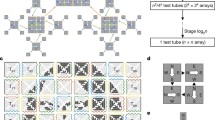Abstract
RNA cotranscriptional folding has been just experimentally proven capable of self-assembling a rectangular tile at nanoscale in vivo (RNA origami). We initiate the theoretical study on the algorithmic self-assembly of shapes by cotranscriptional folding using a novel computational model called the oritatami system. We propose an oritatami system that folds into an arbitrary finite portion of the Heighway dragon fractal, also-known as the paperfolding sequence \(P = \mathrm{RRLRRLLR} \cdots \). The i-th element of P can be obtained by feeding i in binary to a 4-state DFA with output (DFAO). We implement this DFAO and a bit-sequence bifurcator as modules of oritatami system. Combining them with a known binary counter yields the proposed system.
This work is in part supported by JST Program to Disseminate Tenure Tracking System, MEXT, Japan, No. 6F36, by JSPS KAKENHI Grant-in-Aid for Young Scientists (A) No. 16H05854, and by JSPS and NRF under the Japan-Korea Basic Scientific Cooperation Program No. YB29004.
Access this chapter
Tax calculation will be finalised at checkout
Purchases are for personal use only
Similar content being viewed by others
Notes
- 1.
Some of the bead types might be saved but not easily due to the NP-hardness of minimizing the number of bead types without changing the behavior [8].
References
Abelson, H., diSessa, A.: Turtle Geometry The Computer as a Medium for Exploring Mathematics. The MIT Press, London (1981)
Alberts, B., Johnson, A., Lewis, J., Morgan, D., Raff, M., Roberts, K., Walter, P.: Molecular Biology of the Cell, 6th edn. Garland Science, New York and Abingdon (2014)
Allouche, J.P., Shallit, J.: Automatic Sequences: Theory, Applications, Generalizations. Cambridge University Press, Cambridge (2003)
Doty, D.: Theory of algorithmic self-assembly. Commun. ACM 55(12), 78–88 (2012)
Geary, C.W., Andersen, E.S.: Design principles for single-stranded RNA origami structures. In: Murata, S., Kobayashi, S. (eds.) DNA 2014. LNCS, vol. 8727, pp. 1–19. Springer, Cham (2014). https://doi.org/10.1007/978-3-319-11295-4_1
Geary, C., Meunier, P.E., Schabanel, N., Seki, S.: Programming biomolecules that fold greedily during transcription. In: MFCS2016, pp. 43:1–43:14. LIPIcs 58 (2016)
Geary, C., Rothemund, P.W.K., Andersen, E.S.: A single-stranded architecture for cotranscriptional folding of RNA nanostructures. Science 345(6198), 799–804 (2014)
Han, Y.-S., Kim, H.: Ruleset optimization on isomorphic oritatami systems. In: Brijder, R., Qian, L. (eds.) DNA 2017. LNCS, vol. 10467, pp. 33–45. Springer, Cham (2017). https://doi.org/10.1007/978-3-319-66799-7_3
Han, Y.-S., Kim, H., Ota, M., Seki, S.: Nondeterministic seedless oritatami systems and hardness of testing their equivalence. In: Rondelez, Y., Woods, D. (eds.) DNA 2016. LNCS, vol. 9818, pp. 19–34. Springer, Cham (2016). https://doi.org/10.1007/978-3-319-43994-5_2
Ma, J., Holdener, J.: When Thue-Morse meets Koch. Fractals 13, 191–206 (2005)
Ota, M., Seki, S.: Ruleset design problems for oritatami systems. Theor. Comput. Sci. 671, 26–35 (2017)
Patitz, M.J.: Self-assembly of fractals. In: Kao, M.Y. (ed.) Encyclopedia of Algorithms, pp. 1918–1922. Springer, Heidelberg (2016). https://doi.org/10.1007/978-3-642-27848-8
Rothemund, P.W.K., Papadakis, N., Winfree, E.: Algorithmic self-assembly of DNA Sierpinski triangle. PLoS Biol. 2(12), e424 (2004)
Watters, K.E., Strobel, E.J., Yu, A.M., Lis, J.T., Lucks, J.B.: Cotranscriptional folding of a riboswitch at nucleotide resolution. Nat. Struct. Mol. Biol. 23(12), 1124–1133 (2016)
Winfree, E.: Algorithmic self-assembly of DNA. Ph.D. thesis, California Institute of Technology, June 1998
Acknowledgements
We would like to thank Hwee Kim for valuable discussions.
Author information
Authors and Affiliations
Corresponding author
Editor information
Editors and Affiliations
Rights and permissions
Copyright information
© 2018 Springer International Publishing AG, part of Springer Nature
About this paper
Cite this paper
Masuda, Y., Seki, S., Ubukata, Y. (2018). Towards the Algorithmic Molecular Self-assembly of Fractals by Cotranscriptional Folding. In: Câmpeanu, C. (eds) Implementation and Application of Automata. CIAA 2018. Lecture Notes in Computer Science(), vol 10977. Springer, Cham. https://doi.org/10.1007/978-3-319-94812-6_22
Download citation
DOI: https://doi.org/10.1007/978-3-319-94812-6_22
Published:
Publisher Name: Springer, Cham
Print ISBN: 978-3-319-94811-9
Online ISBN: 978-3-319-94812-6
eBook Packages: Computer ScienceComputer Science (R0)




